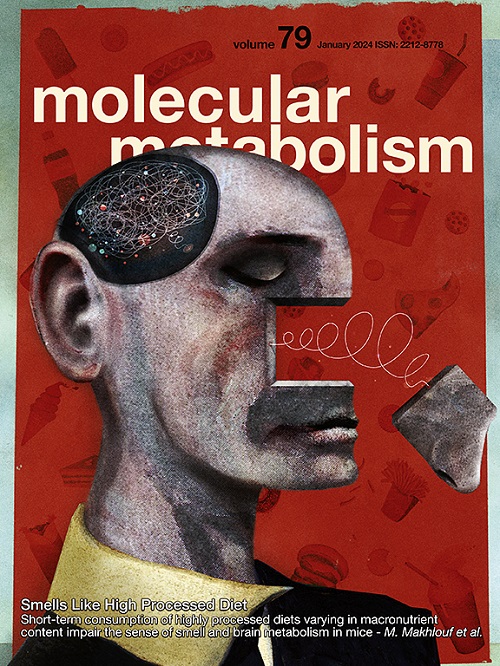Inhibition of Unc119b improves insulin sensitivity through potentiation of Rac1 activation in skeletal muscle and brown adipose tissue
IF 6.6
2区 医学
Q1 ENDOCRINOLOGY & METABOLISM
引用次数: 0
Abstract
Objectives
A hallmark of type II diabetes is an impairment of the glucose transporter GLUT4 translocation to the plasma membrane of specialized cells in response to insulin. Identifying mechanisms involved in this defect is critical to developing treatments that restore insulin sensitivity. We previously identified a small molecule insulin sensitizer, C59, which improves insulin-stimulated GLUT4 translocation through binding to Unc119b, however, the role and mechanism of Unc119b-mediated regulation of GLUT4 trafficking is unknown.
Methods
Here we use in vitro systems and rodent models of insulin resistance with genetic manipulations of Unc119b expression to uncover the role of this protein in the regulation of glucose homeostasis.
Results
We demonstrate that Unc119b is an endogenous inhibitor of GLUT4 translocation which contributes to the development of insulin resistance in obese individuals. We show that Unc119b interacts with Rac1 and inhibits its activation by insulin, resulting in reduced GLUT4 translocation. Both the prenylated C-terminus of Rac1 and C59 bind to the same site within Unc119b, thus suggesting that C59 enhances GLUT4 translocation by interfering with the action of Unc119b on Rac1.
Conclusions
Overall, this study identifies Unc119b as a critical regulator of glucose homeostasis, uncovers its role in GLUT4 trafficking, and identifies the mechanism of action of a new class of insulin sensitizers.
抑制Unc119b通过增强骨骼肌和棕色脂肪组织中Rac1的激活来改善胰岛素敏感性。
目的:II型糖尿病的一个标志是葡萄糖转运蛋白GLUT4转运到特化细胞的质膜上,以响应胰岛素。确定这种缺陷的机制对于开发恢复胰岛素敏感性的治疗方法至关重要。我们之前发现了一种小分子胰岛素增敏剂C59,它通过与Unc119b结合来改善胰岛素刺激的GLUT4易位,然而,Unc119b介导的GLUT4转运调节的作用和机制尚不清楚。方法:本研究利用体外系统和啮齿动物胰岛素抵抗模型,通过基因操作Unc119b表达来揭示该蛋白在葡萄糖稳态调节中的作用。结果:我们证明Unc119b是一种内源性的GLUT4易位抑制剂,有助于肥胖个体胰岛素抵抗的发展。我们发现Unc119b与Rac1相互作用并抑制其被胰岛素激活,导致GLUT4易位减少。Rac1和C59的丙烯化c端都结合在Unc119b内的同一位点上,这表明C59通过干扰Unc119b对Rac1的作用来促进GLUT4易位。结论:总的来说,本研究确定了Unc119b是葡萄糖稳态的关键调节因子,揭示了其在GLUT4运输中的作用,并确定了一类新的胰岛素增敏剂的作用机制。
本文章由计算机程序翻译,如有差异,请以英文原文为准。
求助全文
约1分钟内获得全文
求助全文
来源期刊

Molecular Metabolism
ENDOCRINOLOGY & METABOLISM-
CiteScore
14.50
自引率
2.50%
发文量
219
审稿时长
43 days
期刊介绍:
Molecular Metabolism is a leading journal dedicated to sharing groundbreaking discoveries in the field of energy homeostasis and the underlying factors of metabolic disorders. These disorders include obesity, diabetes, cardiovascular disease, and cancer. Our journal focuses on publishing research driven by hypotheses and conducted to the highest standards, aiming to provide a mechanistic understanding of energy homeostasis-related behavior, physiology, and dysfunction.
We promote interdisciplinary science, covering a broad range of approaches from molecules to humans throughout the lifespan. Our goal is to contribute to transformative research in metabolism, which has the potential to revolutionize the field. By enabling progress in the prognosis, prevention, and ultimately the cure of metabolic disorders and their long-term complications, our journal seeks to better the future of health and well-being.
 求助内容:
求助内容: 应助结果提醒方式:
应助结果提醒方式:


